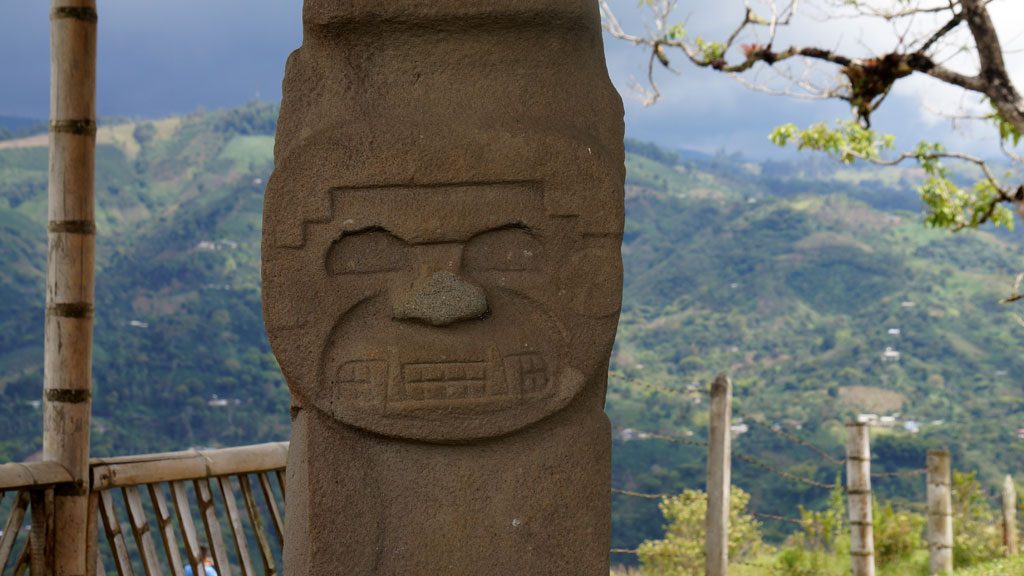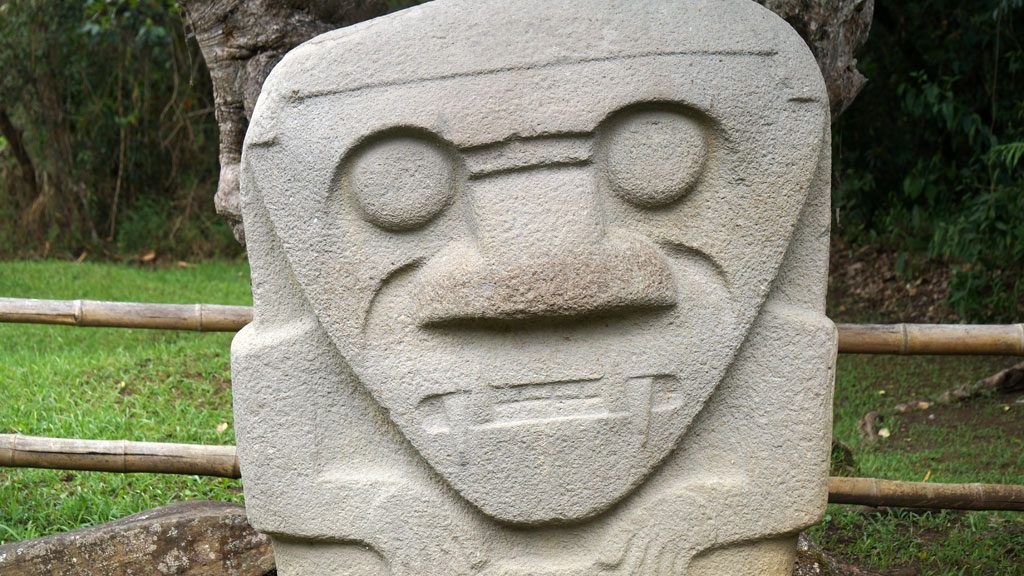Around a little southwest Colombian town called San Agustin lay archaeological remains that tell stories of Gods, masters, and ordinary people belonging to a culture that flourished between the 8th and the 1st century BC.
A UNESCO world heritage since 1995, San Agustin presents the largest group of religious monuments and megalithic sculptures in South America.
Although a park has been created around the monuments, it is rather a collection of ceremonial and burial sites scattered over an area of 250 square miles, and are centered around three areas close to the town: the San Agustin plateaus, the Idols Hill, and the Stones Hill.
A site with a dozen faces
The archaeological landscape hosts sculptures ranging from 20 centimeters to seven meters, from abstract to realist art. The sculptures resemble human figures with threatening, smiling, or somber faces. But also rather divine creatures, warriors armed with clubs, round eyes or jaguars’ teeth of mythical heroes. Some seem to depict serenity and wisdom, others fear and darkness.
Little is known about the communities who built the mythical monuments in San Agustin.
What is known is that the oldest remains of the culture stem from 3300BC. Around 700BC this culture had developed to such an extent that it was able to construct the statues that are its most remarkable remains.
The cultural changes that took place from the 8th to the 1st century BC are what has left the most iconic remains. In this period, the so-called Agustine culture, characterized by the monumental lithic art, dominated the area. Other findings from that time have indicated this culture was able to uphold high standards of agriculture, ceramics and goldsmithing.
However, who these people were, where they came from, what the exact purpose of the gigantic sculptures was, and to what extent the culture was connected to other known cultures that lived in the area at the time, remains unknown.
Archeaologists have found remains of settlements similar to that of the Agustine culture deep in the Amazon jungles of the Caqueta state, 100 miles southwest San Agustin. Other sites might still exist as that part of the jungle has barely been explored by archaeologists.
A complex and intelligent society

While little is known about most of of the ancient Andean people, scholars do have theories on the role of the San Agustin statutes for their culture.
Some claim the sculptures’ played a role in shamanic rituals.
The monuments were allegedly located in the political and demographic centers of a sovereign territory. They could therefore have been used for ceremonial activities and shamanic rituals, but could also also have served to show the prowess of the rulers who order their construction.
The placement of the statues and tombs does show the Andeans’ advanced political or hierarchical system. Moreover, the huge monumental platforms, temple-like architecture, and burial mounds are evidence of a civilization capable of expressing its societal organization and worldview by means of art.
The archaeological leftovers of their society reflect the presence of a complex pre-Hispanic civilization in old San Agustin and the vast area around it.
The San Agustin plateaus
The area around San Agustin takes up about 80 hectares, consisting mainly of “las Mesitas.” or the plateaus. Here you can find eight mounds, over a hundred sculptures and the entire core of the largest demographic and ceremonial centers.
However, San Agustin does not merely show separate monuments, the vestiges tell us about the customs of the communities that lived in an area between Popayan and Neiva thousands of years before Spanish colonists discovered and conquered the Americas.
The residential remains of the elite families that ruled over the society are found here. The families had monuments constructed to be used as burials for their leaders. The oldest and largest tombs – Mesita A and Mesita C- are located in this area.
Idols Hill and Stones Hill
The Idols Hill lies on the bank of the Magdalena river, and the what smaller Stones Hill is located further north. Derived from the biblical figure Mary Magdalena, the Magdalena river is Colombia’s principal river, flowing northwards some 1,528 kilometres through the west of the country.
Both areas contain a variety of archaeological monuments. The ancient trails and field boundaries are visible throughout the entire landscapes, drainage ditches from old agricultural civilizations, artificial platforms and funerary monuments.
This was a sacred land, a place of pilgrimage and ancestors worship. Heroic guards, carved in blocks of tuff and volcanic rock, some reaching up to 4m and weighing several tonnes, stand as protectors of the realm. Safeguarding the monolithic sarcophagi, funeral rooms, and burial sites.



